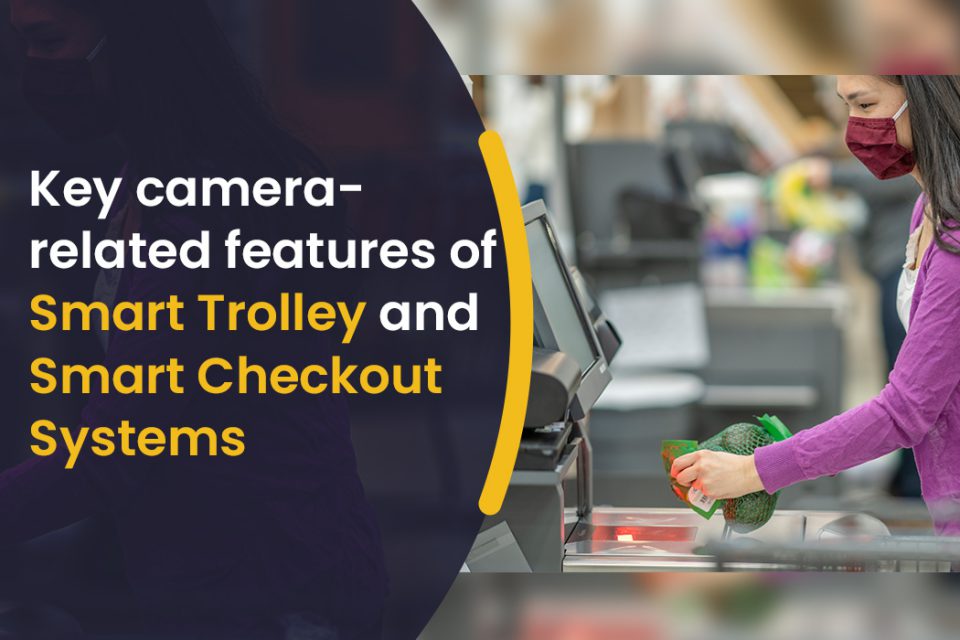Retail as an industry has been one of the slow adopters of technology and automation. However, the past few years have seen many retailers focusing on improving customer and staff experiences by using technology as an enabler in an effort to differentiate from the competition. Especially, the pandemic has accelerated this transformation. And smart trolley and smart checkout systems becoming more and more popular is a testament to this change.
An automated smart trolley or checkout system cannot function without a camera. A camera is necessary to capture and serve the necessary image data for the algorithms to accurately detect and identify objects in a shopping cart. Advancements in embedded vision have made it possible for smart retail device manufacturers to come up with innovative use cases to help retail store owners enhance productivity and improve experience. To learn more about the significance of cameras in these systems, please go through How embedded vision accelerates smart trolley and smart checkout journeys.
What are smart trolley and smart checkout systems?
Though smart trolley and smart checkout systems are both autonomous retail devices, they function differently but with a common purpose – conduct checkout at a retail store automatically. A smart trolley system refers to a retail device equipped with cameras installed in a shopping trolley in order to automatically capture objects dropped into it. At the same time, a smart checkout system usually refers to a camera-enabled automated object detection system at the billing or checkout counter. Both these systems operate autonomously with limited supervision from the retail staff. These smart retail devices offer advantages such as effective utilization of the retail staff, enhanced shopping experience, more data on shopping patterns, etc.
Cameras for smart trolley and smart checkout systems – most critical features
Choosing a camera for autonomous checkout systems is often complex. While the algorithm has to perfect the ability to detect a wide variety of objects in a retail store, the camera has to be able to serve appropriate images to the AI-based object detection software. This has to be done irrespective of the lighting conditions, type of object, size of the trolley, motion of the objects dropped into the trolley, etc. Considering these challenges, following are the factors you need to consider while choosing a camera solution for your autonomous checkout system:
- Ability to capture images in challenging lighting conditions.
- Right shutter type and frame rate
- The best fit optics
- Multi-camera support
- A well-tuned ISP.
- Compatibility with ARM-based platforms
Let us now look at each of them in detail.
Ability to capture images in challenging lighting conditions
This camera requirement can be looked at in two different ways – first the ability of reliable imaging in a wide range of lighting conditions (both bright and dim light), and second is the ability to capture images in extreme low light conditions.
In the case of the former, typically an HDR camera module is recommended. An HDR camera captures multiple frames of the same scene with different exposure times to make sure that – in the output image – the bright areas are not overexposed while at the same time the dim areas are not underexposed. This is useful in a smart checkout system since the lighting conditions in a retail store can vary a lot depending on the time of the day and the lighting setup.
When it comes to a low-light camera module, the high sensitivity of the sensor helps in capturing details in as low a lighting condition as zero lux. Though most of the retail stores are well lit, a low-light camera might be required in some cases. For instance, a low-light camera is particularly helpful in capturing images in a shopping trolley while passing through an aisle where the light supply is limited. However, it is to be noted that a camera with a good dynamic range might also do the job here. This can be decided by properly evaluating the camera solution in all possible scenarios.
Right shutter type and frame rate
In a shopping trolley, the camera has to be able to smoothly capture images of the objects dropped into it. In the case of automated checkout, image capture has to happen mostly when the shopping cart is in motion at the checkout counter. In both scenarios, a camera with the right shutter type and frame rate has to be chosen. Typically, to capture fast-moving objects, a camera with a high frame rate is recommended to eliminate motion blur. If the output image has rolling shutter artifacts, a global shutter camera is preferred over a rolling shutter one.
The best fit optics
The choice of lens in an autonomous checkout system is predominantly determined by the FOV (Field Of View) requirements. The FOV of the lens has to be large enough to cover the entire area of a shopping trolley. A smart trolley or checkout system typically requires a multi-camera system, in which case the cameras together have to cover the complete scene. One thing to note here is that, when a lens supports an FOV, the sensor should also be able to accommodate that particular FOV.
To find the right field of view required for your application, please check out our FOV Calculator.
Multi-camera support
Autonomous checkout systems need more than one camera to capture the entire field of view. Also, object identification algorithms mostly need the object to be captured from different angles for accurate recognition. This demands the system to have multiple cameras that can operate synchronously. For instance, e-CAM25_CUXVR from e-con Systems is a global shutter multi-camera system for NVIDIA Jetson AGX Xavier with the ability to connect up to 6 cameras into a single Jetson system.
A well-tuned ISP
In addition to having the right sensor and optics, ISP also plays a significant role in a camera for smart checkout system. A well-tuned ISP is a must to deliver the required image quality. Depending on the needs of the application, an internal or external ISP can be used. To learn more about ISP tuning and the differences between using an internal and external ISP, please read the article Camera ISP and significance of using an external ISP in imaging solutions.
Compatibility with ARM-based platforms
With the demand for doing analytics at the edge increasing in smart trolley and checkout systems, retail solution providers are moving more and more towards integrating powerful processors into their smart retail devices. Hence, camera solutions designed for these systems need to be compatible with popular ARM-based processors such as NVIDIA Jetson, NXP i.MX series, Google Coral, Raspberry Pi, etc. For example, e-con Systems offers MIPI cameras and GMSL cameras that are compatible with a wide range of processors and carrier boards.
That wraps up the key camera related features of smart trolley and smart checkout systems. Following is a list of cameras from e-con Systems that are suitable for smart checkout systems:
- See3CAM_CU20: Full HD USB HDR camera
- See3CAM_CU55: 5MP low noise USB camera
- e-CAM20_CU0230_MOD: 2MP wide temperature range industrial-grade HDR camera
- e-CAM55_CUMI0521_MOD: 5MP AR0521 MIPI camera module
- e-CAM217_CUMI0234_MOD: Full HD colour global shutter camera module
- See3CAM_24CUG: Full HD USB colour global shutter camera
e-con Systems has worked with many smart retail device manufacturers to smoothly integrate our cameras into their systems. See how e-con Systems helped a leading US based smart retail solution provider develop a next-gen camera-based smart checkout system.
If you are looking for help in integrating world-class cameras into your smart retail device, please write to us at camerasolutions@e-consystems.com. To learn more about our wide portfolio of cameras, please visit our Camera Selector.

Ranjith is a camera solution architect with over 16 years of experience in embedded product development, electronics design, and product solutioning. In e-con Systems, he has been responsible for building 100+ vision solutions for customers spanning multiple areas within retail including self service kiosks, access control systems, smart checkouts and carts, retail monitoring systems, and much more.


